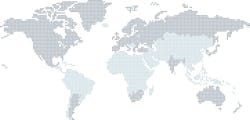Business Forum: International export control policies are up for discussion—what does it mean for the laser industry?
JENNIFER DOURIS O'BRYAN, Government Affairs Director, SPIE
Every laser manufacturing company that has international business may be affected by export control policies set under the Wassenaar Arrangement (WA; Vienna, Austria), which is an international body that sets standards on export control regulations that the 42 member countries agree to implement within their own countries’ regulations (see figure). Each year, these countries send delegates to WA to negotiate proposals submitted by individual countries to either increase or decrease the agreed-upon level of export control.
These proposals are often generated by an industry within a country and submitted to their government officials to consider as a government-backed proposal to be brought to WA for consideration. SPIE will assist in coordinating proposals that are supported by the broader international laser community, as well as provide a forum for reaching collective agreement on challenges in defining laser technology within the regulations.
In many cases, the need for decontrol in regulation is a result of growth in manufacturing of a controlled item by a country that does not abide by the Wassenaar agreements. This kind of availability of a controlled item from a non-WA country would not only render the control ineffective in preventing proliferation, it would also put companies based in countries instituting export controls on the item at a competitive disadvantage.
Another reason that proposals for decontrol may be brought forward is if the controlled technology area has progressed to the point that the controlled item is no longer considered militarily significant. In either case, these reasons are rarely seen or limited to industry based in one country, but instead the impact of this need for decontrol is felt by any company producing the controlled item.
A recent challenge that will be part of the 2020 discussions at WA is how to define quasi-continuous-wave (QCW) lasers within regulation. Current controls apply to both pulsed and continuous-wave (CW) lasers. Determining where within the control text QCW lasers falls is currently a point of debate and the solution may require clarifying changes to the definitions that apply to laser controls in general.
The QCW discussion among others will be part of the agenda of an international laser working group meeting being hosted at SPIE Photonics West on February 5, 2020. In addition, we will be discussing current WA proposals of interest to the laser community that were submitted by industry to the U.S. government for consideration, but are likely proposals that will garner support from the broader international community that produces these items.
One of these proposals is to update controls on the CW mid-infrared (mid-IR) laser power threshold. In the past, high-powered CW mid-IR lasers were developed mainly for military purposes, which still holds true for very-high power levels. However, current controls limit the power threshold to 1 W—any higher and the laser is caught within the dual-use controls.
The proposal brought forward by industry would increase this level to 10 W. Commercial uses for lasers within this power range include biological sensing, waveguide and microcavity characterization, and environmental studies. In addition to the lessened military significance of these items, lasers in the 1–10 W range are being manufactured by companies based in countries that do not abide by WA, and the technical data to produce these items is widely available.
Another proposal being put forward is to release from controls certain industrial lasers in the 1–6 kW range with a beam parameter product above 1.0 mm-mrad. High-power CW fiber lasers have revolutionized many areas of manufacturing over the last decade, as their prices have decreased and more manufacturers entered the market. These lasers have been increasingly adopted for a growing number of commercial materials processing applications, such as cutting, welding, brazing, and surface treatment.
Given the considerable commercial demand for these applications, it is not surprising that more manufacturers are producing industrial lasers with better beam quality. The increased availability of these lasers in countries not abiding by WA controls is the main motivation for this proposal.
Jennifer Douris O’Bryan ([email protected]) will be presenting more information on international export controls and the Wassenaar Arrangement at the 32nd annual Lasers & Photonics Marketplace Seminar, to be held February 3, 2020, during SPIE Photonics West.
